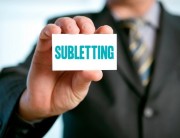January 15, 2013
One aspect of reducing costs when managing a rental property is to limit the expenses associated with tenant turnover. Tenant turnover often entails a renovation of the rental property — in order for the rental unit to attract a new tenant, it must be professionally painted, cleaned or touched up, with carpets cleaned or replaced. The key in knowing what expenses to cover and what expenses to charge back to the tenant is in knowing the condition of the property before and after a tenancy.
To this end, keeping a written “Move-In/Move-Out” checklist that allows both parties to keep track of the state of the property at the times of “Move-In” and “Move-Out” eliminates any misunderstandings regarding which party will pay for certain damages upon move out. An inspection of the property with the tenant before move-in – for the sake of documenting the condition of the unit for the checklist – is vital. It is necessary to take notes on the condition of screens, windows, appliances, blinds, walls, doors, lighting, heating, flooring, a/c, toilets, faucets, ceiling fans and any other aspect of the interior and exterior of the rental unit. Remember to have the tenant sign and date the document after the initial walk-through with the tenants. The use of a video camera or digital camera is also recommended upon both “Move-in”and “Move-out” – the images will help stave off any tenant challenges in the future, i.e.: the “It was that way when we moved in” argument.
Alternatively, the checklist serves as a valuable reference point if and when the tenant requests a repair that is outside the scope of the normal wear and tear of a unit. In this case, the checklist will safeguard the landlord’s right to charge the tenant for the repair, if it is found that the damage incurred falls outside the bounds of normal wear and tear. The checklist favors both parties in that it can protect the tenant from unnecessary security deposit deductions while also protecting the property owner from costly damages to the rental unit. For the property owner, the existence of the checklist sends a clear signal to the tenant about his/her responsibilities in taking care of the rental unit during tenancy. The tenant, in turn, can rest easy knowing that if they maintain the property they will receive their security deposit back when the lease ends.
Clearly, the “Move-In/Move-Out” checklist benefits both the landlord and tenant and should be standard policy both when a tenant moves in and moves out.











There are some interesting points in time in this article but I don’t know if I see all of them center to heart. There is some validity but I will take hold opinion until I look into it further. Good article , thanks and we want more! Added to FeedBurner as well
An impressive share, I just given this onto a colleague who was doing a little analysis on this. And he in fact bought me breakfast because I found it for him.. smile. So let me reword that: Thnx for the treat! But yeah Thnkx for spending the time to discuss this, I feel strongly about it and love reading more on this topic. If possible, as you become expertise, would you mind updating your blog with more details? It is highly helpful for me. Big thumb up for this blog post!
Spot on with this write-up, I truly think this website needs much more consideration. I’ll probably be again to read much more, thanks for that info.
I am often to blogging and i really appreciate your content. The article has really peaks my interest. I am going to bookmark your site and keep checking for new information.
Really happy to hear that! Thanks so much for the positive feedback